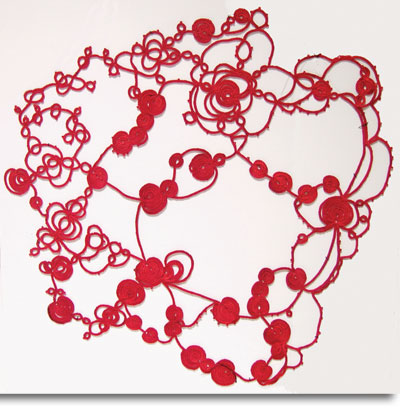Oct 2008

PORTLAND
As a medium, sewing is laden, if not saddled,
with the collective cultural history of craft, femininity, and the trappings of
domestic life. The group show “Blurring the Line” aimed to recontextualize the
needle and thread circa 2008 by way of four artists, all female and all with
ties to the Pacific Northwest, a region whose character was as much forged by
hardy pioneer women as it was by lumberjacks and longshoremen. The show’s
thesis—that formally rigorous, painstakingly executed work transcends sexual or
aesthetic ghettoization—was less than revolutionary, however, this did not
detract from its pleasures.
Jen Pack’s intricately sewn chiffon,
stretched across wooden frames, by turns evoked color-field painting and kente
cloth. Her Green/Yellow Diptych, with its gorgeous silk striations, recalled her
work in previous solo outings at the gallery, while pieces such as Green Bikini
evolved in less sumptuous, more conceptual directions. A sheet of green chiffon
shot through with unruly thatches of blood-orange thread, the work evoked
hirsute profusions or viscera glimpsed as if with X-ray vision. This proved a
welcome foray into the outré for an artist normally concerned with pristine form
and the absolutism of beauty. Meantime, Diem Chau’s embroidered figures on silk
organza, displayed on dinner plates, depicted women sans faces, only
half-filled-in with fabric. In these ciphers lurked the question of how much of
contemporary womanhood is anchored to traditional mores, how much is predicated
by free will, and how much is a tabula rasa awaiting new paradigms.
For
her part, Hildur Bjarnadóttir created patterns in tatted cotton that referenced
the traditions of her native Iceland. Her doily-like Doodles in green, black,
red, and blue suggested that quoting folk-art forms (with appropriate
smatterings of irony) is perhaps the sincerest (if not the most visually
satisfying) form of flattery. The show’s sculptural presence came courtesy of
Linda Hutchens, who sculpts pieced organza to create her work. Shaped like eggs
and braided rope, the works were delicate, smooth, and transparent, suggesting a
duet between material and immaterial, the there and the not-there. As such, they
came perhaps closer than any entry in Blurring the Line... to concretizing the
often problematic relationship between the feminine mystique and the
post-feminist condition.
“Red Doodle,” 2007, Hildur Bjarnadóttir,
Tatted cotton yarn, 16" x 15"
Photo: courtesy of Pulliam Deffenbaugh
Gallery
